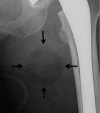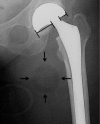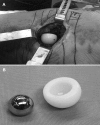Total Hip Arthroplasty Dislocations Are More Complex Than They Appear: A Case Report of Intraprosthetic Dislocation of an Anatomic Dual-Mobility Implant After Closed Reduction
- PMID: 27303232
- PMCID: PMC4896666
Total Hip Arthroplasty Dislocations Are More Complex Than They Appear: A Case Report of Intraprosthetic Dislocation of an Anatomic Dual-Mobility Implant After Closed Reduction
Abstract
Background: Total hip arthroplasty is a successful operation for the treatment of hip pain. One of the common complications of hip arthroplasty is dislocation. While reduction of standard prosthetic dislocations is highly successful, new prostheses add the potential for new complications.
Case report: We present the case of a patient who experienced intraprosthetic dislocation of an anatomic dual-mobility total hip prosthesis after a closed hip reduction and include the prereduction and postreduction radiographic findings.
Conclusion: Emergency department physicians should be aware of intraprosthetic dislocation. This complication can be easily missed because the metal/ceramic femoral head appears to be reduced in the acetabulum.
Keywords: Arthroplasty–replacement–hip; hip dislocation; hip prosthesis.
Figures







References
-
- Kurtz S, Ong K, Lau E, Mowat F, Halpern M. Projections of primary and revision hip and knee arthroplasty in the United States from 2005 to 2030. J Bone Joint Surg Am. 2007. April; 89 4: 780- 785. - PubMed
-
- Kwon MS, Kuskowski M, Mulhall KJ, Macaulay W, Brown TE, Saleh KJ. Does surgical approach affect total hip arthroplasty dislocation rates? Clin Orthop Relat Res. 2006. June; 447: 34- 38. - PubMed
-
- Cornwall R, Radomisli TE. Nerve injury in traumatic dislocation of the hip. Clin Orthop Relat Res. 2000. August; 377: 84- 91. - PubMed
-
- Li E, Meding JB, Ritter MA, Keating EM, Faris PM. The natural history of a posteriorly dislocated total hip replacement. J Arthroplasty. 1999. December; 14 8: 964- 968. - PubMed
-
- Philippot R, Adam P, Farizon F, Fessy MH, Bousquet G. Survival of cementless dual mobility sockets: ten-year follow-up [In French]. Rev Chir Orthop Reparatrice Appar Mot. 2006. June; 92 4: 326- 331. - PubMed
Publication types
LinkOut - more resources
Full Text Sources
